There’s a new way to deliver sales growth…
Don’t buy Sales Training until you’ve watched this video…
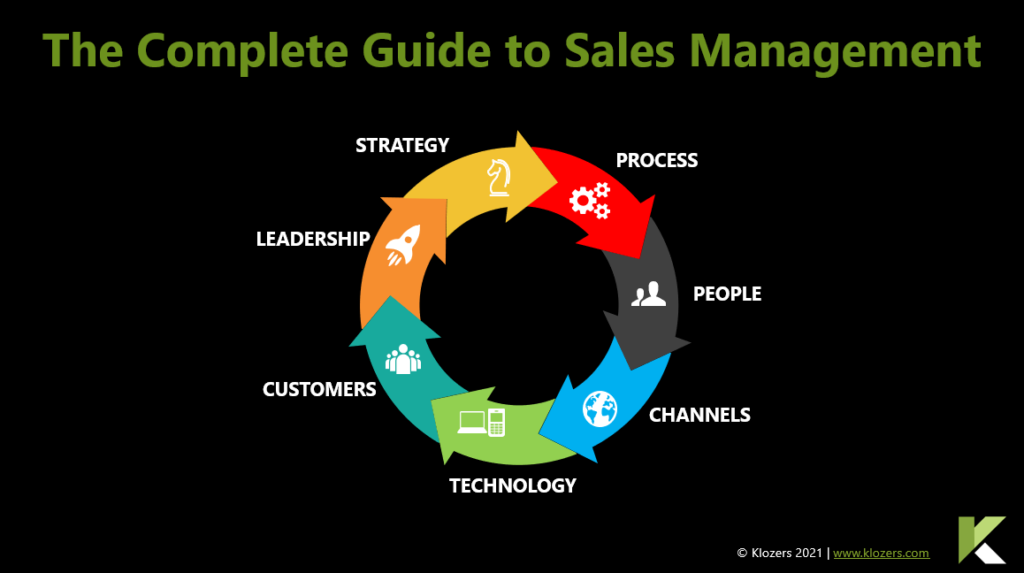
Sales Management is the leadership, management and administration of several interlocking sales functions, that enable organisations to meet or exceed the objectives of the company’s growth strategy. The nature of Sales Management can include many different roles such as Customer Relationship Management, Strategy, Process, Territory Management, Technology & Tools, Pipeline Management, Hiring and Sales Coaching.
Sales Management is important because it provides the structure, support and environment for salespeople to exceed their goals. Furthermore, Sales Managers set an often subconscious bar on what productivity and performance are acceptable in the business from which Salespeople take their lead. The advent of new technologies has increased the workload and complexities of Sales Managers, especially when many still carry a sales target. These new technologies and the new markets now available over the web, can make the Sales Manager the difference between a business surviving or thriving.
Don’t buy Sales Training until you’ve watched this video…
“The most useful and best days training I’ve ever had. Love your style.”
Gary CEO
The Sales Management Strategy you use is dependent on the type of sales team that you are running or taking over (if you are a new hire). Given how fast the Sales Environment changes it’s unwise to create any Strategy for longer than three years. Even within three years, part of your Strategy will need to be revised due to changes in the market and technology and the ability to drive and accept is one of the key features in the Sales Maturity Model. Your Strategy should revolve around the following:
Sales Maturity indicates the position the sales team is in, within the Sales Maturity Model. This is important because at each stage of Sales Maturity a Sales Manager is faced with different problems and what may be important in Stage 3 is simply not applicable in Stage 1.
The function of Sales is to meet or exceed the objectives that the business has set. These may be short term and more tactical in their nature or long term and more strategic. Whilst long term 3-year Strategic objectives may be important it’s worthless if the business can’t meet it’s short term requirements for cash flow, which may require some tactical planning to overcome.
As Sales are the lifeblood of every business, then salespeople are the lifeblood of the Sales Department. For any Sales Management Process & Strategy to be effective you will need the Salespeople and Team Leaders to be able to execute the strategy. This can then create difficult choices between strategy and people. As an example, should you retain a top-performing salesperson when they are hugely disruptive, if part of your longer-term strategy is to improve the culture, and sales skills of the sales team? Should I provide sales training to salespeople who do not want it, despite the fact they are underperforming?
Regardless of where the sales team is in terms of maturity and competence, you will need to create a plan to share with the other stakeholders in the business. It makes sense then to benchmark where the sales team is against the industry best practice. From these results, you can create an Improvement Plan that you can follow.
Regardless of the products, services or industry, every successful business has 7 common sales management areas. The complexity and importance will however, vary for every company, what works best for Microsoft might not work for Apple.
What works best for a Mid Market company may not work for an SME. They do however, all have these 7 common sales functions which can be used as a framework to benchmark and audit any sales unit.
a) Is the Sales Strategy aligned with the overall growth strategy of the business?
b) Do the Salespeople follow the Sales Strategy?
a) Are there defined and comprehensive sales processes in place?
b) Are the sales processes being consistently followed and recorded by everyone?
a) Is the business recruiting, developing and hiring the right people?
b) Does the Sales Unit objectively record people performance and review accordingly?
a) Are all the appropriate sales channels being used?
b) Are all the sales channels adequately supported and managed?
a) Does the sales technology, tools and data enhance the customer experience?
b) Does the sales technology tools and data provide accurate management reports and accountability?
a) How are our customer relationships segmented and managed?
b) How do we measure, record and report success in our customer relationships?
a) Are Sales Leaders creating a positive and supportive environment that rewards and encourages success?
b) Do the Sales Leaders lead or do they manage?
Once the Sales Unit has been benchmarked and an Improvement Plan has been created, it’s important to set new Sales Management Goals & KPI’s.
A Goal would relate to our end objective, whereas a KPI is a milestone on the route to achieving a goal. One without the other is worthless.
These goals should include rolling 30, 60 and 90 Day targets in addition to Q1, 2, 3 & 4.
It’s important that any KPI’s you set are within your control and you have the ability to influence, whether you meet the target or not.
The Goals and KPI’s should, where possible be, “Lead Indicators” and not “Lag Indicators”, for example Monthly Sales Revenue is a Lag Indicator that in some instances you have little control over.
What you can control however is the Monthly Sales Activity that drives those revenue figures.
Lagging indicators are also important and must be recorded and used to influence future Lead Indicators.
In certain circumstances, it may not be possible to measure the KPI’s if the systems and reporting are not available.
This could mean in the short term the priority is to create the recording and reporting systems.
This can be dangerous, as an example you may need to completely replace a CRM system, which can be a huge project as you migrate data and face the unknown and complex technical issues, as well as the natural resistance encountered with Change.
Where possible delay any complex and technical projects and focus on the low hanging fruit and use the shiny new CRM that everyone wants as a reward for hitting new sales targets.
Use a Sales Management System to create either manual Dashboards in MS Excel or digital dashboards in your CRM, to record and track the Goals and KPI’s.
We use a Sales Scorecard System based on Harvards Balanced Scorecard which we have adapted to sales.
The Scorecard focuses on the four main areas of Sales which are Finding New Sales Opportunities, Klozing More Sales Opportunities and Growing More Sales Opportunities.
The last quadrant is called the Developing quadrant and focuses on the development of the Salespeople.
| TABLE OF SALES MANAGEMENT KPI’s | |||
|---|---|---|---|
| 1. | Initial Sales Meetings | In B2B Sales most sales start with a meeting but this could be a Webinar or Call | |
| 2. | Follow Up Sales Meetings | Number of follow up meetings per month | |
| 3. | No of Qualified Proposals | Number of Qualified Proposals Generated per month | |
| 4. | New Customer Acquisition | The rate of new customers joining the business per month | |
| 5. | Sales by Channel | The sales revenue figures for each channel per month | |
| 6. | Number of Contract Renewals | The number of contract renewals per month | |
| 7. | Customer Satisfaction Scores | Feedback & reviews collated from Customers | |
| 8. | Sales Pipeline Value | The total value of the current months Sales Pipeline | |
| 9. | Weighted Sales Pipeline Value | The weighted (by percentage/stage) value of the current Sales Pipeline | |
| 10. | Sales Rep Churn | Number of Reps leaving the business per quarter | |
| 11. | Sales Rep Training Number of training hours developing and growing the sales reps
12. | Sales Rep Coaching | Number of 1-2-1 Coaching Sessions each Rep has received, usually 2 per month |
| 13. | Sales Rep Attainment | Number of Reps reaching “On Track” or higher during monthly reviews | |
| 14. | Sales Rep Targets | Number of Reps meeting or exceeding Sales Targets | |
| 15. | Closing Ratios | The ratio of deals closed from qualified sales leads | |
| 16. | Returned Leads | The number of leads returned to marketing for nurturing | |
| 17. | Cross & Up Selling | Number of Reps meeting or exceeding targets | |
| 18. | Sales Cycle | Speed in days the prospect progresses through the Sales Pipe | |
| 19. | Customer Satisfaction Scores | Feedback & reviews collated from Customers | |
| 20. | COCA | Cost of Customer Acquisition | |
| 21. | Average deal size | The average value of the last months deals | |
| 22. | Sales by Channel | The sales revenue figures for each channel | |
| 23. | New Accounts by Channel | The number of new accounts opened by sales channel |
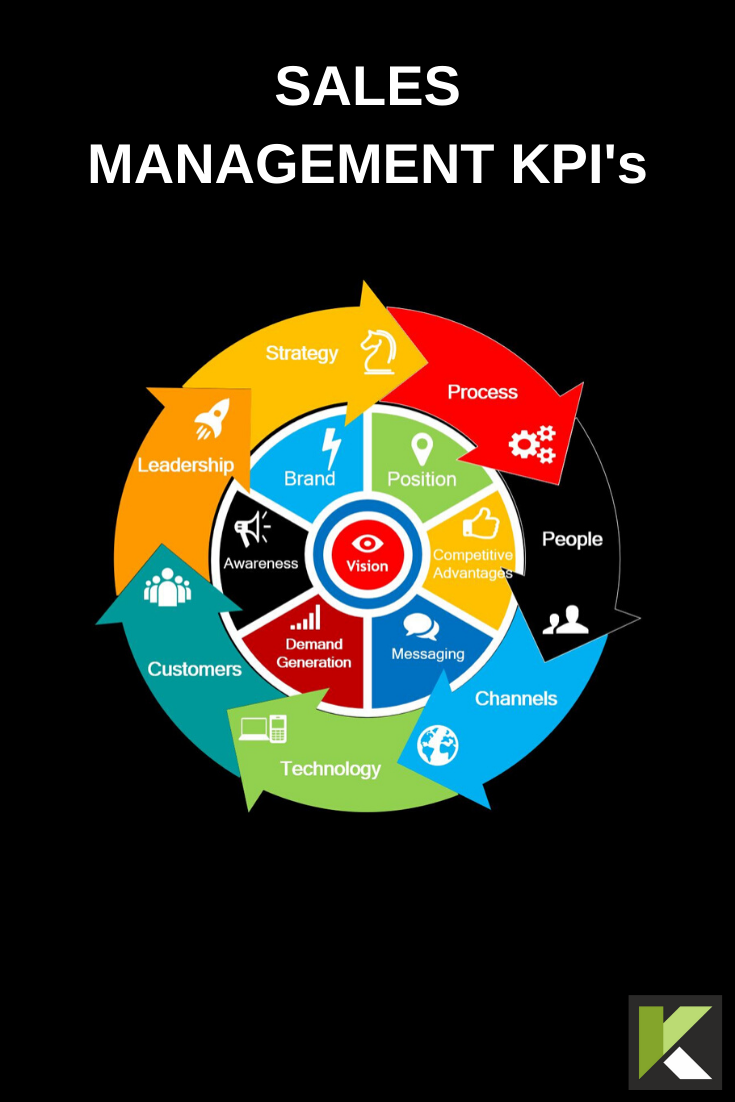
Every individual has their own style or approach to management and these different styles are aligned with their individual DiSC profile.
The DiSC model is based on theories developed by early 20th-century behavioural scientists who identified four behavioural dimensions. Most behavioural analysis today builds on the workings of Carl Gustav Jung in 1928, one of the original behavioural scientists. In the 1940s and 1950s, the DISC theory was refined from the original Jungian theory.
The genesis of these theories is said to be from the Greek philosopher Empedocles in BC444, who first defined the four dimensions of a personality as Water, Air, Earth & Fire.
These styles are not “can do” or “can’t do”, nor do they measure skills or intelligence. There are genuinely no right or wrong answers other than the truthful one. In the same way that people can be left or right-handed, a person’s mind can be influenced by one of the four quadrants.
This is not to say they do not retain traits of one or more of the other quadrants, but that every human being has a preferred style or way of behaving.
DiSC reports are never 100% accurate however they do give a credible diagnosis of behavioural strengths and weaknesses from which our Leadership Styles emerge.
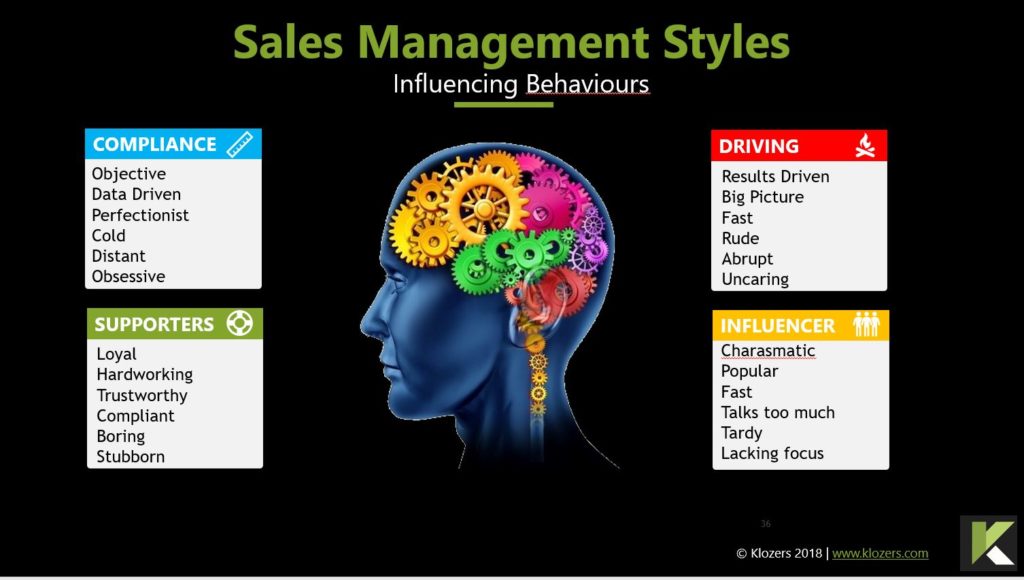
DRIVERS
Combination of task orientation and proactive attitude.
INFLUENCERS/ENERGISERS
A combination of people focuses and a proactive attitude.
STEADINESS/SUPPORTERS
A combination of people-orientation and a passive/reactive attitude.
COMPLIANCE/ CORRECTNESS
A combination of task orientation and a passive/reactive attitude.
Sales Management training is arguably more important than training salespeople, as the Manager sets the bar in terms of performance.
The manager sets the sales strategy, creates the sales plans and holds the salespeople accountable for executing the plan.
Sales Training costs in the UK vary from free courses online and free workshops, up to £2,000 for the larger brands however, the majority of courses available are either one or two day courses, and these typically cost between £300 and £900 per person, per day.
We have a selection of training courses available from around £500 per per day covering Consultative Selling Skills, Sales Management Training and Key Account Management Training.
Sales Management training typically includes the following core topics:
| SALES MANAGEMENT TRAINING TOPICS | |
|---|---|
| Recruiting & Hiring | How to find and hire great salespeople and then successfully onboard them. |
| Management | How to successfully manage a winning sales team. |
| Training & Coaching | How people learn and how to coach them into Sales Champions. |
| Sales Strategy | How to differentiate your products and services and sell more. |
| Sales Pipeline Management | Understanding, Measuring & managing a modern sales pipeline. |
| Planning & Analysis | Analysis and planning for sales growth. |
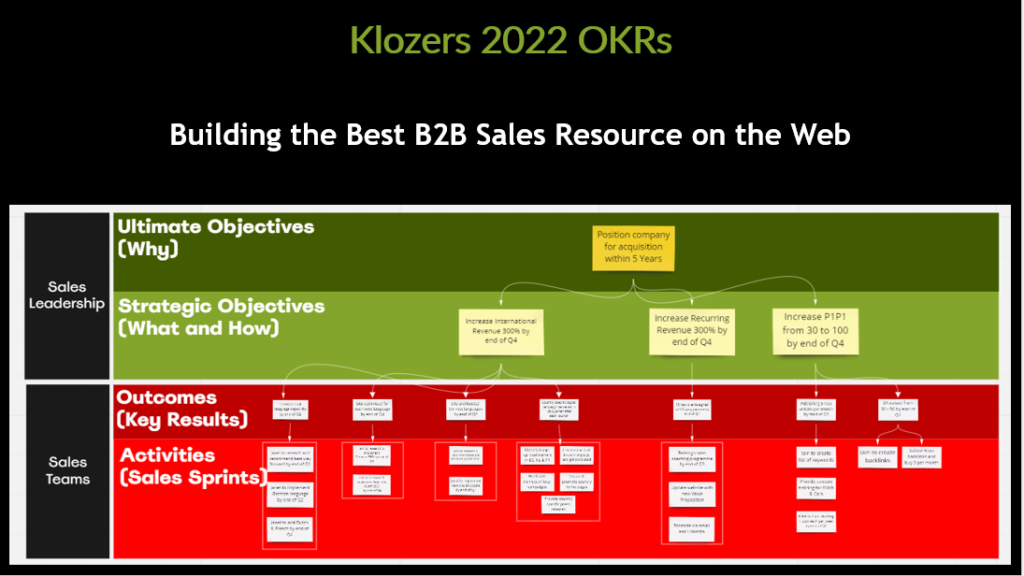
There are many different types of Sales Management Tools available, the majority of which are some form of CRM (Customer Relationship Management) Tools. Whilst these are invaluable, there are many other equally important, productive and necessary tools available, depending on your requirements. Sales Management tools are predominantly broken down into these types:
In many cases companies have multiple systems that don’t integrate and can cause inaccurate & duplication of data, and the repetition of certain tasks which lowers productivity. As an example, it’s not uncommon for a marketing database to be separate to the sales database, nor would it be uncommon for Finance to have a different database for invoicing. These are legacy systems, that both the company and technology have outgrown and are best removed or updated.
It is widely accepted in modern management thinking that people are the most important component in any business, and Sales is no different. If you don’t look after your salespeople they won’t look after your customers and if you grow a business, you must first grow the people in the business.
Providing regular, fair and objective performance reviews ensures Salespeople are aligned with the business objectives, performing at or above the expected level and motivating them to keep going and do better, and lastly, as recognition of their efforts.
Professional Selling can be difficult, frustrating, stressful and anxious, and that’s on a good day, so you may benefit from providing reviews on a Monthly rather than Annual basis. Although this does take up more Management Time, the payback in performance and team morale is huge (if it is done correctly).
Sales People respond well when Monthly Performance Reviews are introduce, as all human beings want to be the best they can. No one wants to do a bad job, it’s just that life, circumstances, people, technology and stuff get in the way.
A Performance Review is therefore, an opportunity to help the salespeople be successful, to grow and to develop.
Sales Managers are sometimes uncomfortable with Monthly reviews as they are forever busy and don’t need the additional workload. Also, they often believe there is no need for reviews as they talk to their people every day.
This is not the same as a structured, objective and professional review. It’s also possible that some sales managers are simply uncomfortable in the coaching role as they have either no system, no process or haven’t had the necessary training.
The biggest asset any organisation has is it’s people and given the high proportion of bad hires and the inherent cost in a new employee who does not work out, more frequent reviews might be worth exploring.
Staff Performance Reviews do take up Management time, however they are essential if you want to keep your workforce engaged, growing and delivering value to the business.
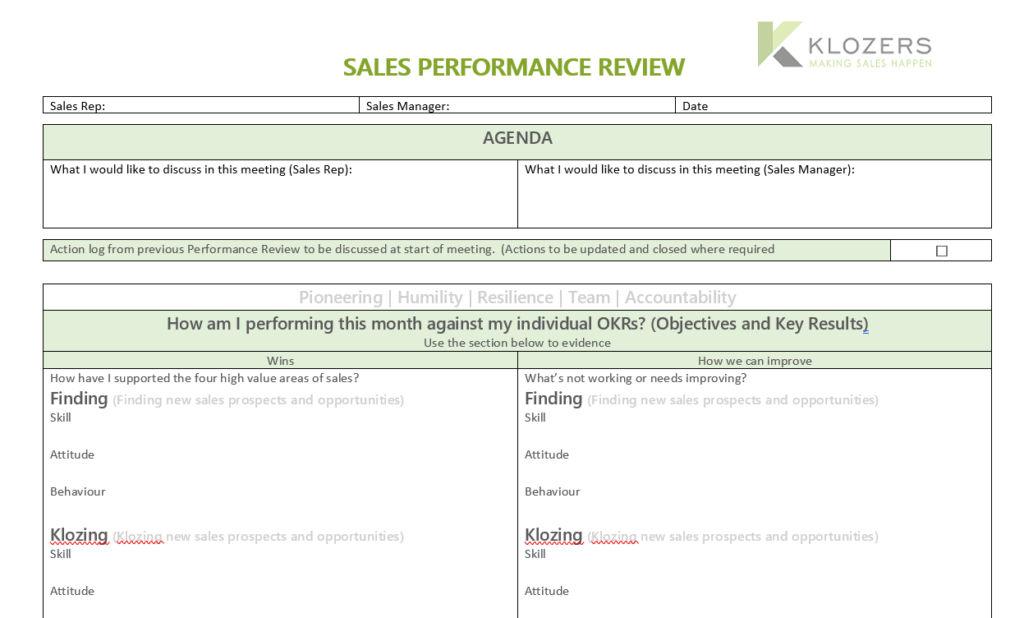
With the advent of modern technology, Sales Analysis has become a bigger and more important part of the role of modern Sales Managers. Working knowledge of Excel spreadsheets is required in addition to proficiency in the companies sales system. For the most part, this would be the CRM [Customer Relationship Management] tool that the company was using, however the more mature the Sales Organisation the more likely they are to be using additional technology with data. This could include HR Systems, Sales Compensation software, Sales Enablement tools and Marketing tools, if used in Sales Campaigns.
Typical examples of sales analysis would include:
Completing any Sales Analysis is dependent on accurate and up to date data, which is often not available.

Sales Territory Management is the process by which companies segment and manage and service the customer accounts within a defined geographical territory.
There are many variables involved in this and hence Territory Plans may look very different from one company and territory to another.
Enterprise organisations typically have Territory Plans in place with pre-defined lists of target accounts set by Management. These “named” accounts will have been segmented into importance with more time being allocated to the larger, more profitable accounts. Often salespeople are not allowed or credited for other accounts or business in the territory when operating named account lists.
The Sales Person for a Territory will have to maintain or increase the revenue from existing clients and develop and open new accounts in the territory.
Territory plans include the frequency and number of visits the Sales Rep must conduct with each of the accounts.
Territory plans are usually reviewed by sales Management every Quarter at a meeting called a QBR (Quarterly Business Review). At these meetings, salespeople present an update or progress report and a revised plan for the next 90 days.
Whilst most industries follow similar naming conventions for job roles in sales, many companies have developed their own unique roles and job titles.
Often job titles are important as a form of recognition and progression within an organisation, however, job titles can help reinforce a structure and sales process such as in the SaaS industry.
There are hundreds of job titles and we have listed what could be argued are the most common.
| Sales Development Rep | Focused on lead generation and sit between marketing and sales qualifying leads before passing onto sales people |
| Pre-sales Technical | Provides technical expertise before a sale is made to ensure compliance, compatibility and customer satisfaction post sale |
| Business Development Reps | Primarily focused on opening new accounts and winning new business |
| Inside Sales | Desk based salespeople who undertake a range of sales activities |
| Account Managers | Primarily focused on retaining and growing existing customer accounts |
| Field Sales Reps | Field based sales reps who undertake a variety of sales activities externally |
| Channel Sales Manager | Provides support and manage the Channel partners |
Providing regular sales training and coaching to your sales team is an important part of every effective sales management sales management process. Sales Training and coaching come in many different formats from 1 off event bases sales training, to longer term sales programmes, focussing or professional development.
Regardless of the format, sales training should always be linked to the objectives and sales goals of the team. Whilst this may seem obvious many companies opt for generic sales training which covers a number of important topics, however, without a direct link to the every day activities of the sales team there is often little behavioural change.
Our preference is to provide any training and coaching via an OKR based model. This model fits and compliments perfectly the normal KPI based sales management process. We have continually found an OKR based approach provides better sales outcomes for both small businesses and large enterprises.
Product or service training where possible should avoid the traditional features and benefits based approach and focus on selling what we call business solutions that solve business problems using a consultative led approach.
“A fantastic learning experience”
Amanda – Account Manager

Iain Swanston has spent over 30 years in B2B sales selling, training and leading teams both domestically and internationally. In addition he serves as an Associate at Strathclyde University Business School where he has delivered the sales content for the Masters in Entrepreneurship since 2015.
107a High Street
Dalkeith
EH22 1AX
United Kingdom
8911 North Capital of Texas Highway, Suite 4200 #1154
Austin, TX 78759
United States
Klozers
Ground Floor
470 St Kilda Road
Melbourne VIC
3004